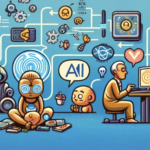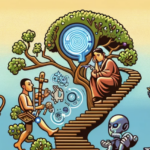![7+ Differences between Machine Learning and AI [Applications & Top Products]](https://softwareblade.com/wp-content/uploads/2022/03/Screen-Shot-2022-03-30-at-4.00.42-PM.png)
Artificial intelligence (AI) and machine learning (ML) are similar but different.
AI is defined as the ability of a machine to imitate human cognitive abilities, while ML is a subset of AI that deals with giving machines the ability to learn from data.
In practice, ML is used to create algorithms that can improve automatically over time as they receive more data.
One key difference between AI and ML is that AI relies on pre-determined rules, while ML is able to learn on its own by analyzing data.
This means that ML can find patterns in data that humans would not be able to see. Additionally, AI is typically used for tasks such as decision-making, whereas ML is used for tasks such as prediction or classification.
ML has become increasingly popular in recent years due to the advances in big data and GPUs.
In short, AI is the ability of a machine to imitate human cognitive abilities, while ML is a subset of AI that deals with giving machines the ability to learn from data.
Deep learning is also a subset of machine learning.

ML has become increasingly popular in recent years due to the advances in big data and GPUs.
Table of Contents
Neural networks
One way to train a computer to emulate human reasoning is to use a neural network, which is a set of algorithms modeled after the human brain.
Neural networks are composed of a large number of interconnected processing nodes, or neurons, that can learn to recognize patterns of input data.
Neural networks are used in AI and ML to create models of data. These models can then be used to make predictions or decisions.
For example, a neural network might be used to predict whether a customer will renew their subscription or not.
How AI and machine learning work together
The following steps are involved in getting AI and machine learning to work together.
Step 1
An AI model is built using machine learning and other techniques.
Step 2
Machine learning models are made by studying patterns in data.
Step 3
Data scientists will then improve and optimize the machine learning models based on patterns in the data and depending on the nature of the problem.
Step 4
The process is repeated and is refined until the accuracy of the models is high enough for the tasks that need to be completed.
Modeling closed systems (e.g., a game of chess where there’s a fixed environment and fixed rules) is easier than modeling open systems (e.g., financial markets).
Capabilities of AI and machine learning
AI and machine learning are often thought of as being very powerful technologies. However, it’s important to understand the limitations of both AI and machine learning.
AI is good at completing tasks that are well-defined and that have a set of fixed rules. For example, playing a game of chess or Go is something that can be done using AI.
However, as mentioned, tasks that involve dealing with open systems (e.g., potential military conflicts) are much more difficult for AI to handle.
Machine learning is good at recognizing patterns in data and making predictions based on those patterns.
However, machine learning is not perfect and can sometimes make mistakes.
Additionally, machine learning can be biased if the data used to train the model is not representative of the real world. As the saying goes, “garbage in, garbage out.”
In short, AI is good at completing tasks that are well-defined and that have a set of fixed rules.
How businesses are using AI and machine learning
Many businesses are now using AI and machine learning to improve their products and services.
Google uses machine learning to improve its search results, while e-commerce platforms commonly use it to recommend products to customers.
Netflix uses machine learning to recommend movies and TV shows to its users, and Facebook uses it to show them ads that they might be interested in.
In short, many businesses are now using AI and machine learning to improve their products and services.
Predictive analytics
Predictive analytics is a type of AI that is used to make predictions about the future.
It can be used to predict things such as how many people will renew their subscription, how much inventory needs to be ordered, and what the weather will be like tomorrow.
Recommendation engines
Recommendation engines are a type of machine learning algorithm that are used to recommend products, services, or content to users.
This is how YouTube recommends content to its users, while eBay and Walmart use it to recommend products to customers.
Clustering
Clustering is a technique that is used in machine learning to group similar items together.
For example, clustering could be used to group all the songs by The Beatles together, or all the pictures of cats together.
Neural networks
Neural networks are a type of machine learning algorithm that are designed to mimic the way the brain works.
They are able to learn and improve their performance over time, and can be used for tasks such as image recognition and natural language processing (NLP).
Supervised learning
Supervised learning is a type of machine learning algorithm that is used to learn how to perform a task by example.
For example, supervised learning could be used to teach a computer to recognize pictures of cats.
Unsupervised learning
Unsupervised learning is a type of machine learning algorithm that is used to learn from data that has not been labeled or pre-determined.
For example, unsupervised learning could be used to group all the songs by The Beatles together, or group all the pictures of cats together.
Speech recognition and natural language understanding
Speech recognition and natural language understanding are two tasks that are commonly performed by neural networks.
Speech recognition is the process of recognizing speech and converting it into text, while natural language understanding is the process of understanding the meaning of text.
Image and video processing
Image and video processing are tasks that can be performed by neural networks.
Image processing is the process of manipulating images, while video processing is the process of manipulating videos.
Sentiment analysis
Sentiment analysis is the process of identifying the sentiment (positive, negative, or neutral) of text.
It can be used to determine how people feel about a product, company, or politician, for example.
Applications of AI and machine learning
There are various applications of AI and machine learning.
Here are the main industries where AI and machine learning are taking off:
Retail
Retail is one industry where AI and machine learning are being used to improve the customer experience.
For example, Amazon uses machine learning algorithms to recommend products to customers, and Netflix uses them to recommend movies and TV shows.
Healthcare
AI and machine learning are being used in the healthcare industry to improve patient care.
For example, IBM has developed a system called Watson that can help doctors diagnose diseases using natural language processing.
Finance and banking
AI and machine learning are being used in the finance industry to make investment decisions.
For example, Goldman Sachs has developed a system called Marquee that uses machine learning algorithms to predict stock prices.
Automotive and transportation
AI and machine learning are being used in the automotive industry to make self-driving cars.
For example, Google has developed a system called Waymo that uses machine learning to control the car’s steering, braking, and navigation.
Defense
AI and machine learning are being used in the defense industry to improve security.
For example, the Defense Advanced Research Projects Agency (DARPA) is working on a project called XAI that uses machine learning to identify threats online.
Education
AI and machine learning are being used in the education industry to improve teaching methods.
For example, Google has developed a system called Classroom that helps teachers manage their classes online.
Enterprise management
AI and machine learning are being used in the enterprise management industry to improve business processes.
For example, Oracle has developed a system called Autonomous Database that uses machine learning to optimize database performance.
Sales and marketing
AI and machine learning are being used in the sales and marketing industry to improve customer engagement.
For example, Salesforce has developed a system called Einstein that uses machine learning to recommend products to customers.
Cybersecurity
Cybersecurity is another industry where AI and machine learning are common to protect online data, files, and information and prevent fraud.
For example, Symantec has developed a system called Norton that uses machine learning to detect and prevent cyberattacks.
Customer service
AI and machine learning are being used in the customer service industry to improve the customer experience.
For example, Apple has developed a system called Siri that uses machine learning to answer questions and provide recommendations.
Transportation
Transportation is an industry where AI and machine learning are being used to improve the transportation experience.
For example, Uber has developed a system called UberEats that uses machine learning to recommend restaurants to customers.
Manufacturing
Manufacturing uses AI and ML to help robots and automated systems on the production line.
One robot might be told to go and get a tool from a shelf, and another might be told how to weld two pieces of metal together.
Top AI and machine learning products on the market
The following are the top AI and machine learning systems on the market.
Microsoft Azure AI
Microsoft has Azure AI, a suite of services that enable developers to build AI applications.
The services include Azure Machine Learning, which is a platform for constructing, training, and deploying machine learning models.
Google Cloud Machine Learning
Google has Cloud Machine Learning, a platform for training and deploying machine learning models.
The platform includes the TensorFlow machine learning library and the Prediction API, which is used to make predictions about text, images, and other types of data.
Amazon AWS AI Services
AWS offers a range of AI services, including:
- Amazon Rekognition, which is a service for recognizing objects in images and videos, and
- Amazon Comprehend, which is a service for understanding text
IBM Watson
IBM Watson is a platform for building AI applications.
It includes services such as Watson Studio, which is a platform for developing and deploying machine learning models, and Watson Explorer, which is a search and discovery service for finding information across multiple data sources.
Conclusion
There are many differences between machine learning and AI.
Machine learning is a technique that is used to improve performance over time, while AI is a field of study that deals with making predictions about the future and understanding human intelligence.
Machine learning uses algorithms to learn from data, whereas AI uses algorithms to learn how to solve problems.
Machine learning can be used for tasks such as image recognition and natural language processing, while AI can be used for tasks such as predictive analytics and decision support.
Machine learning is used to improve business processes, while AI is used to create intelligent systems.
In short, the main differences between machine learning and AI are:
1) Machine learning is used to learn from data that has been largely pre-determined, while AI is used to learn from data that has not been pre-determined.
2) Machine learning is mainly used for tasks such as speech recognition and natural language understanding, while AI is used for tasks such as image and video processing, sentiment analysis, and enterprise management.
3) Machine learning algorithms are designed to improve over time, while AI algorithms may or may not be designed to do so, depending on the purpose and application.


![Backwards 3: How to Type "Ɛ" [EASY]](https://softwareblade.com/wp-content/uploads/2022/02/Screen-Shot-2022-02-19-at-9.03.25-PM-150x150.png)